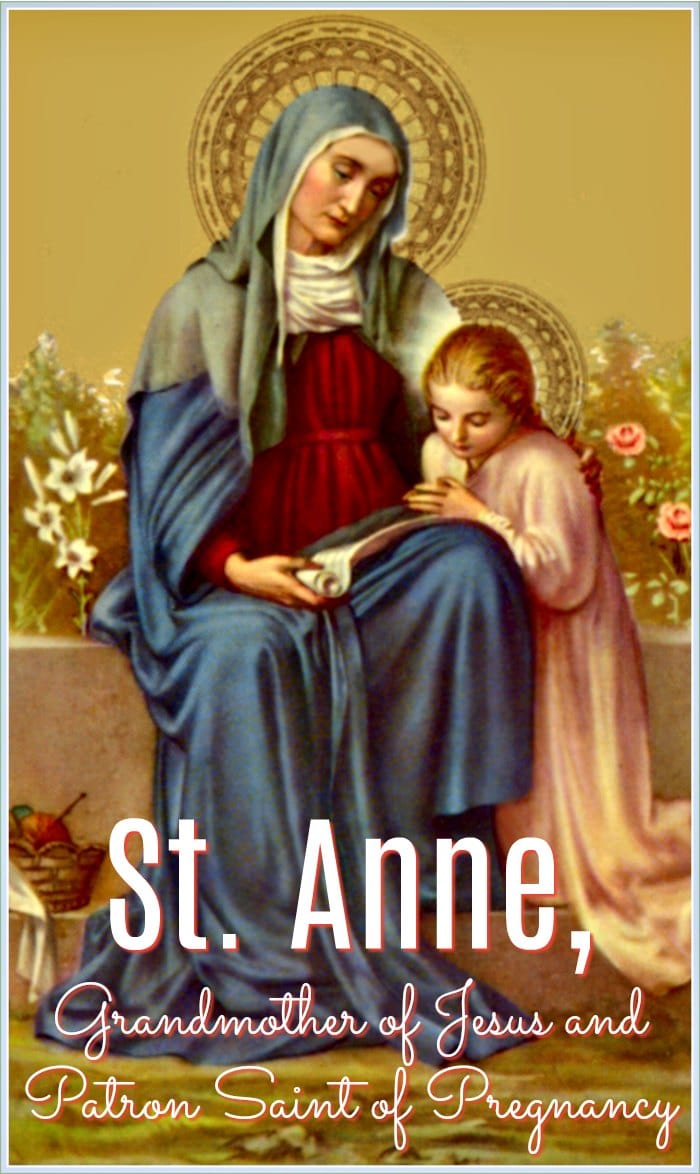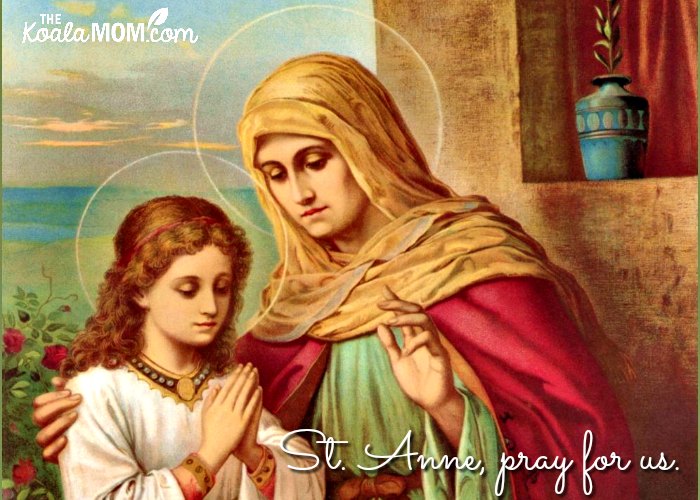Grandmothers are often the first to find out about a new baby and the first to hold a baby after his or her birth. My mom was the first to see both Sunshine and Joey after their births, and my mother-in-law was the first to visit Lily. It makes sense that Jesus’ grandmother, St. Anne, would be a patron saint of pregnancy and childbirth as well as mothers and grandmothers.

This post contains affiliate links; as an Amazon Associate, I earn from qualifying purchases.
St. Anne and her husband St. Joachim are not mentioned in the Bible. Little is known about this couple and their life with their daughter Mary. Church tradition holds that St. Anne was an older woman when Mary was born (like her relative St. Elizabeth). Mary is said to be their only child and was dedicated to God at a young age, much like Samuel in the Old Testament.
Despite this, there is much we can learn from St. Anne. She serves as “a great model of virtue to all engaged in the married state, and charged with the education of children” (Butler’s Lives of the Saints). St. Anne raised the young woman whom, out of all the young women in Israel (or even the world at that time), God choose to be the mother of His Son. I often ask her to pray that I may raise children who was as eager to say “yes” to God as Mary was.
St. Anne lived in an era when married women were expected to have children. Those who didn’t were seen as having displeased God somehow. So she knows what it’s like to desire children and to bear society’s scorn for not filling a certain role. St. Anne is the patron not only of expectant mothers, but also childless mothers. Those who are struggling to conceive can pray for St. Anne’s intercession and follow her example of hopeful piety.
Today, women live in an era when we are often looked down upon if we choose to be “only” mothers. St. Anne shows us that it is more than enough to be a mother. She’s known only to posterity as a mother—the mother of the greatest woman in history. As Butler says, she “was chosen by God to form his most beloved spouse to perfect virtue; and her pious care of this illustrious daughter was the greatest means of her own sanctification and her glory in the church of God to the end of ages. It is a lesson to all parents whose principal duty is the holy education of their children. By this they glorify their Creator, perpetuate his honour on earth to future ages, and santity their own souls.”

The work of raising children, especially as Catholic mothers, is the most important work we can do. As a booklet about St. Anne points out, “Many if not most of the saints have had holy mothers, mothers who understood the tremendous responsibility of Christian motherhood, and who strove to instil into their children’s minds the truths of religion from the first moment of the dawn of reason.” The mothers of St. Therese the Little Flower, St. Augustine, and others jump to mind, but “if the mothers of saints and all good mothers deserve to be praised and honoured, what praise and honour are great enough for her who was worthy to be mother of the Queen of Saints, good Saint Anne, grandmother according to the flesh of Our Saviour Jesus Christ?”
What a privilege and what a responsibility is a mother’s! It would almost seem as though she could make her child a saint if she set her mind to it, if she began with the infant, with the tender sapling, training it to grow in the right way while it is capable of being trained. Surely, no commendation is too high for a good mother. ~ Good St. Anne
In The Big Book of Women Saints, Sarah Gallick notes that “Anne’s color is emerald green and she protects pregnant women who wear green. Traditionally venerated on Tuesdays, she is especially pleased by those who attend Mass and Communion or give alms in her honor on that day. Others honor Anne by saying nine Hail Marys to commemorate the nine months she carried her daughter.”
St. Anne was also venerated by the early Canadian fur traders, many of whom were Catholic. One thinks of the many mothers who were praying for their sons so far from home, exploring the wilds of Canada in the 1700s and 1800s. Alexander Henry the Elder wrote that “Saint Anne is the patroness of the Canadians, in all their travels by water.” Peter Pond (a rather fiery and infamous fur trader, and founding partner of the North West Company) and John Macdonnel (a clerk in the North West Company) both mention Sainte-Anne-de-Beaupré in Quebec, a last stop for voyageurs setting out down the river.
Today, the Basilica at Sainte-Anne-de-Beaupré is still a popular place for pilgrimage. The first chapel was built here in 1658, when a settler donated two acres of his land for a shrine. The first reported miracle happened here during the shrine’s construction, when a man hired to help build the church was cured of his rheumatism. The local First Nations people called St. Anne “the grandmother of the faith.”
Anne is a powerful intercessor, especially for mothers and those who want to become mothers. She is a model for married women and a protector of widows. With Joachim she is a patron of married couples. ~ The Big Book of Women Saints
St. Anne’s feast day is celebrated on July 26. She is the patron saint of pregnancy, childless people, expectant mothers, grandmothers and mothers, homemakers and housewives, and women in labour.

No Responses Yet